Snow white terraces created from hot underground springs cascade down the hillside creating a spectacular sight similar to a snow covered mountain. The terraces enclose pools of clear blue water and as the setting sun slides towards the horizon spectacular reflections are created. On first glance you might wonder with all the hills of pure white snow why it isn’t cold, but is not snow just calcium deposits with pools of a luxurious temperature.
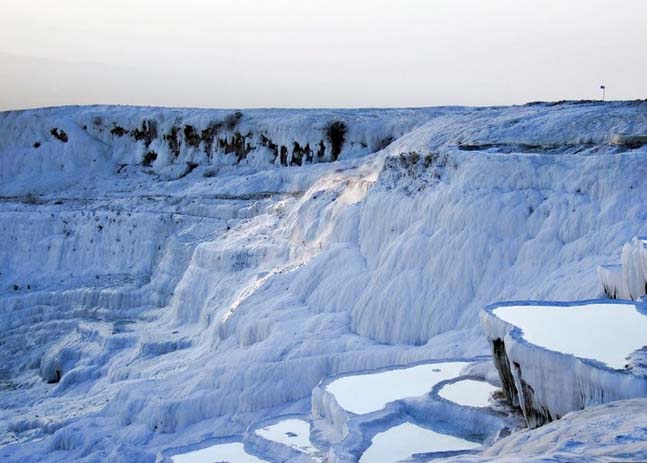
From the lower regions you can see why it has the name “Pumukkale”, which literally translates to “cotton castle” in Turkish. These great walls of calcium with their water smoothed soft edges rise like a solid unmoving cloud.
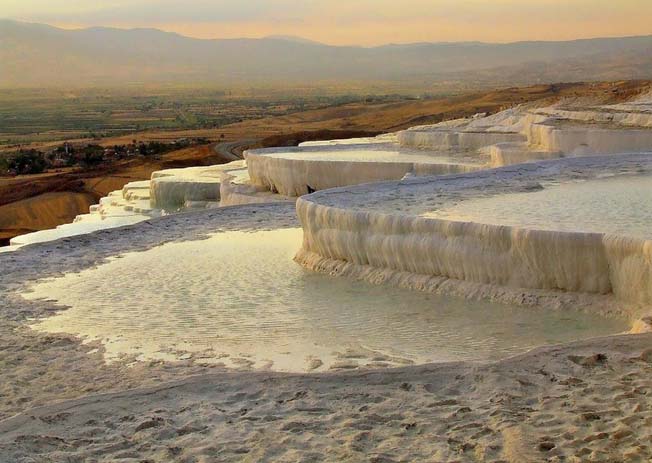
When you go to the top of this surreal setting its real beauty can be appreciated, like some giant champagne tower of the gods, small pools, terraced in their snow white framework flow continually into each other cascading into the sunset.
What exactly is the Pamukkale Pools?
These are the natural pools in Pamakkale located in southwest Turkey in the Denizli region and are a registered UNESCO World Heritage site. Eventually the calcium turns quite hard, but initially it is soft, which is why for the most part swimming and walking in the pools is all but banned. Even to walk around you have to take your shoes off as the calcium deposits are easily worn down.
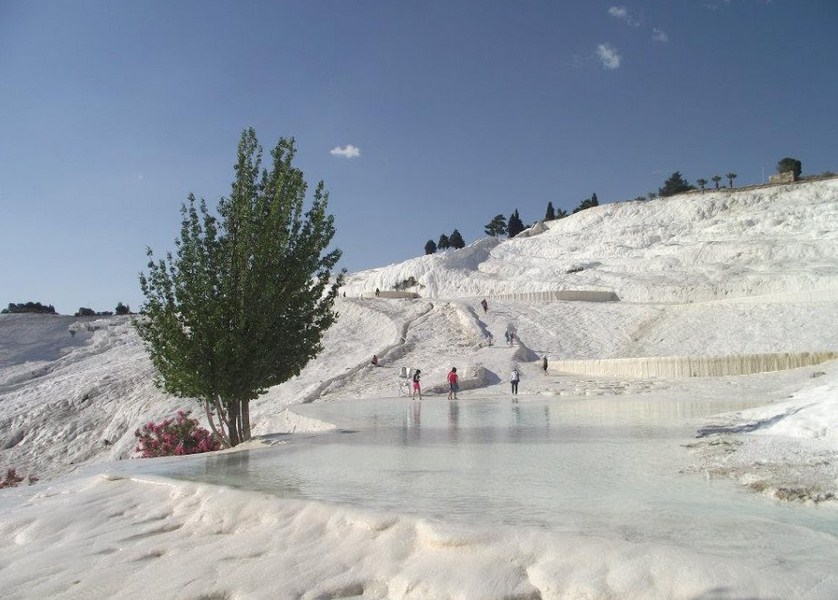
The pools are created from spring water rising from the ground at a point almost three hundred meters from the actual pools, the water emerges warm, around 35 degrees and is full of calcium. As it emerges and flows down the hills the calcium is deposited and slowly builds up creating the snow white terraces that hold small pools of light blue water.
When is the best time to go there?
One of the best things about this amazing place is that almost any time of year is a viable option in which to visit. During the peak season in summer the temperature can be anywhere from 30 to 40 degrees Celsius, which might sound harsh but will make that swim in the pools a real treat. The only real downside is that it will be very crowded at this time as it peak tourist season.
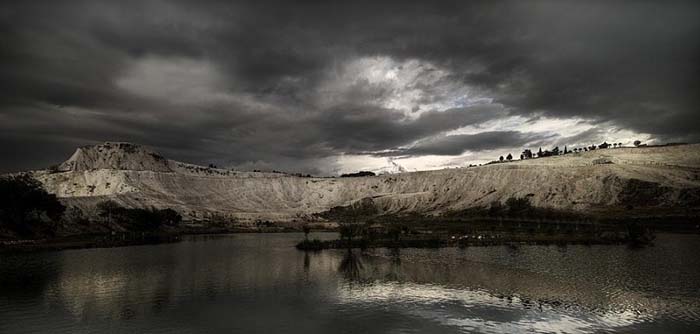
On the other hand this natural wonder can also be appreciated in the winter, because of the geological setting the temperature never really gets below 0 degrees and it only ever snows one or two days of the year. Even if does get very cold you can fight that off by warming up in the thermal pools that are warm all year round (and you probably won’t have to share them with a busload of other tourists).
Spring and autumn are probably the best times to visit as the temperature is moderate and the place won’t be nearly as packed as it will be in the summer.
What else can I do in these ancient pools?
Even though the biggest attraction is the pools the area is filled with ancient ruins, it is not just our contemporaries that appreciate such a wonder. The Romans were taking advantage of the health benefits of the springs and mineral water long ago, and the Turkish were using it to bolster tourism, this is why the ruins of the ancient Roman spa city of Hierapolis can also be explored here.
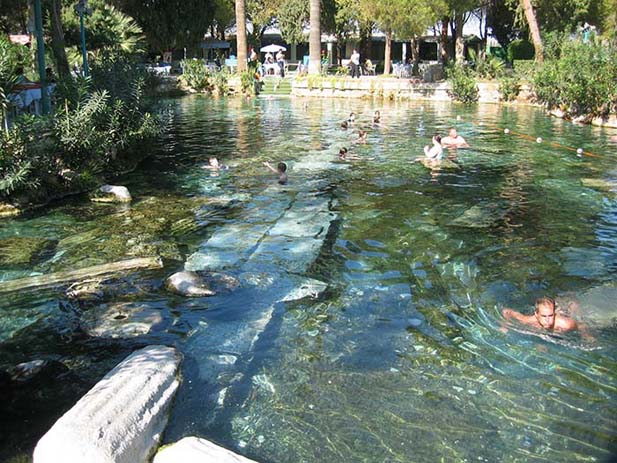
As amazing as the pools are, the ruins of the ancient Roman town of Hierapolis are a fascinating look into how people lived in the past. The Romans valued the healing properties of the hot springs so much there was a whole town built around them complete with a theatre.
The grand street is excavated and partly restored giving a time travel experience, as well as this there is a disproportionately large Roman necropolis (cemetery), filled with a seemingly disproportionate amount of grand Roman tombs for such a small city. It seems that while the pools feel nice they don’t possess that many actual healing powers, they lured many rich dying Romans hoping for a miracle in their last days, the bonus being that what they left behind is an eerily grand cemetery to wander through.
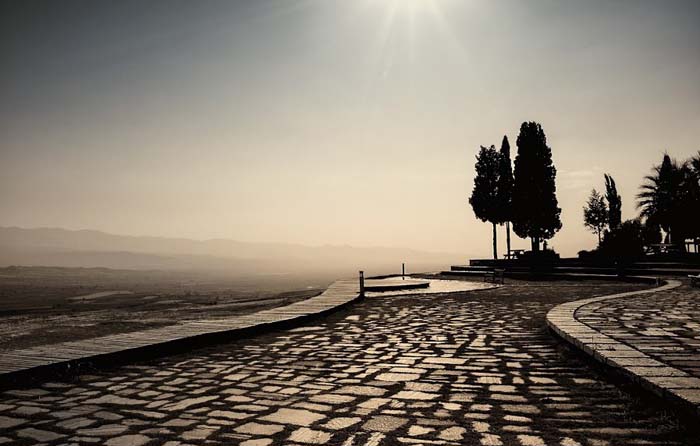
At the heart of the Hierapolis is the antique bath. At this ancient bathing spot you can continue your time warp experience by taking a dip in the thermal pools used by the ancient Romans. These baths are filled with actual ancient collapsed Roman columns. Here you can attain a connection with the people thousands of years ago, enjoying the same natural wonder you take in today.
Just up the hillside from the ancient pools is a carefully restored Roman theatre. Being an amphitheatre it gives this spot not only historical value, but the topological setting gives a great view of the town and the surrounding landscape. This is great spot where you can enjoy both a natural wonder of the world and get a great insight into how people thousands of years ago lived and also appreciated such a natural phenomenon.
How do I get there and where do I stay?
The best way get to Pamukkale is from the nearby city of Denizli. Travelling from Pamukkale to anywhere else can prove to be quite difficult. There are buses that run all day between Pamukkale and Denizli. Travelling in and out of Denizli is easy as there is a major bus terminal, a train station, and an airport connecting with major Turkish cities.

A highly recommended place to stay is the Artemis Yoruk Hotel; this hotel also acts as hostel with dorms, has a warm atmosphere and is great for friendly travellers. The location is only a few minutes walk from the pools, ruins and the town centre. Getting to the hotel is no problem as they offer free transfers from Denizli bus station, the bus stops literally 15 meters away from the hotel in Pamukkale Centrum.
This hotel is located at Pamukkale Kasabasi Ataturk Cad 20280 Pamukkale Turkey and their phone number is +90 258 272 2073
http://www.gopamukkale.com/pamukkale-travertine-terraces/
http://www.timetravelturtle.com/2012/09/pamukkale-hierapolis-turkey/
http://www.hostelworld.com/hosteldetails.php/Artemis-Yoruk-Hotel/Pamukkale/16038
http://www.turkeytravelplanner.com/go/Aegean/Pamukkale/sights/

